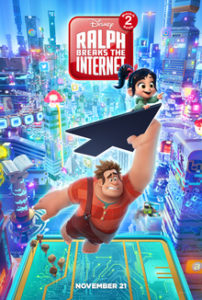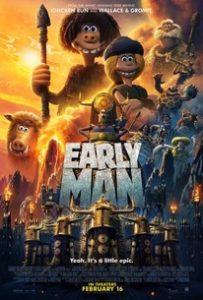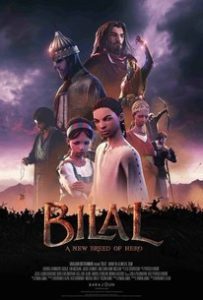Trailer — Ralph Breaks the Internet: Wreck-It Ralph 2
Posted on June 7, 2018 at 8:00 am

In theaters this Thanksgiving — Ralph and Vanellope go from 8-bit world to the present in this sequel with cameos from lots of Disney characters:
Posted on June 7, 2018 at 8:00 am

In theaters this Thanksgiving — Ralph and Vanellope go from 8-bit world to the present in this sequel with cameos from lots of Disney characters:
Posted on June 5, 2018 at 8:49 am

Posted on March 22, 2018 at 5:33 pm
B +| Lowest Recommended Age: | High School |
| MPAA Rating: | Rated PG-13 for thematic elements and some violent images |
| Profanity: | Some strong language |
| Alcohol/ Drugs: | None |
| Violence/ Scariness: | Dog and human peril and violence, murder, sad death of parents, child injured badly, medical procedures, starvation and disease, skeletons, some disturbing images |
| Diversity Issues: | Issue of white American as the only one who takes on the villain |
| Date Released to Theaters: | March 23, 2018 |
| Date Released to DVD: | July 16, 2018 |

Say the title out loud. “Isle of Dogs” = “I love dogs,” get it? Even a three-word title of a Wes Anderson movie is a bit of a puzzle box. Anderson is the Joseph Cornell of filmmakers, with every item on screen and even those tucked away and not seen by the audience, every note on the soundtrack, meticulously assembled. It makes sense that this film is set in a fictional version of Japan because his movies are cinematic Bento boxes. Anderson’s most ardent fans love the understated drama and endless unpacking of detail and think there is a deeper meaning in the weirdness. I am less persuaded that there is always a deeper meaning, but I enjoy the singular peculiarity of his storytelling.
Like my favorite Anderson movie, “Fantastic Mr. Fox,” “Isle of Dogs” is a story of talking animals told via stop-motion animation. This is a vastly more ambitious undertaking, based on an original story by Anderson with frequent collaborators Roman Coppola, Jason Schwartzman, and Kunichi Nomura, who appeared in Anderson’s “Grand Budapest Hotel” and also served as a casting director for this film and provided the voice for the movie’s bad guy.
Anderson’s intricate vision makes for exceptional world-building, and in this film he imagines a Japan 20 years from now, when political and environmental decay has progressed significantly but is seen as normal by the population. Mayor Kobayashi (Nomura) is the mayor of the (fictional) coastal metropolis called Megasaki City. He persuades the population that dogs are a pestilential force, bringing disease (“snout fever” and “dog flu”) to the city, and decrees that all dogs, even the beloved guard dog of his adopted son Atari (Koyu Rankin), must be deported to a nearby “island” made up of trash. The starving, diseased, homesick dogs have a bleak existence on the island. And then Atari arrives, in an airplane, in search of his beloved Spots. And a teenage American exchange student (Greta Gerwig) starts to investigate, with one of those old-school evidence walls covered with clues linked together by red yarn. Anderson’s worst and most tone-deaf choice here is to make the one white, American human character the only one with any integrity and ability to resolve the crimes against the dogs and community.
As in all Anderson films, the human characters deliver their lines in deadpan even while experiencing cataclysmic loss, urgent action, or ardent emotion. What some audiences experience as whimsical, charming, and witty, others see as cloying, twee, or claustrophobic. But he is a marvel at world-building and here, as in “Fantastic Mr. Fox,” where the entire film is essentially a set of dollhouses over which he has complete control, he is at his best. The settings in this film are an astonishing achievement of imagination and skill, from the tears welling up in the eyes of a dog to the intricacy of the machinery. If he ever devotes as much attention to the humanity of his characters as he does to the brilliance of his props, he will no longer be admired primarily for his singular aesthetic vision but for his characters and stories.
Parents should know that this film includes diseased and starving animals, children and adults in peril, murder, death of parents, child injured badly, dog fights with animals injured and killed, skeletons, some disturbing images including surgery, brief strong language, and references to dogs mating.
Family discussion: Why were the dogs banned? Why was it important for them to vote on big decisions?
If you like this, try: “Fantastic Mr. Fox” and “Kubo and the Two Strings”
Posted on February 15, 2018 at 12:00 pm
B| Lowest Recommended Age: | Kindergarten - 3rd Grade |
| MPAA Rating: | Rated PG for rude humor and some action |
| Profanity: | Some schoolyard language |
| Alcohol/ Drugs: | None |
| Violence/ Scariness: | Comic peril and threats of violence |
| Diversity Issues: | A theme of the movie |
| Date Released to Theaters: | February 16, 2018 |
| Date Released to DVD: | May 21, 2018 |

Even lesser Aardman is still worth watching. “Early Man” is decidedly lesser Aardman than the sublime “Wallace and Gromit” series and “Shaun the Sheep,” but that still makes it a pleasant little treat.
The “early men” are Stone Age denizens Dug (Eddie Redmayne) and his friends, led by the Chief (Timothy Spall), who appears to be quite elderly, but that’s by Stone Age standards. He’s in his 30’s. These people are extremely primitive. They live in caves and their most advanced technology is Flintstones-style use of animals (beetles as hair clippers, tiny crocodiles as clothespins for what barely, and I mean that literally, qualify as clothes). They are not quite sure what it means to be human, and I mean that literally as well. One “member” of their group is a boulder they refer to as “Mr. Rock.” They barely qualify as hunter/gatherers. While they go out with spears every day to try to get rabbits to eat, they are not very good at communicating with each other, or aiming, or hitting anything they aim at.
And then one day their idyllic little territory is invaded by a group riding armor-clad mammoths. It is the Bronze Age and they want to take over the area for mining. Ultimately, it will come down to an unusual but rather progressive way for solving border disputes: a soccer game (which they call football). On one side, champions who are highly skilled professionals with lots of experience but are arrogant prima donnas. On the other side, a bunch of people who have not yet invented the wheel and have never played before. But they have two advantages: a gifted Bronze Age player who has never been allowed on the field because she is a woman (now you know why we call sexism prehistoric), and, just possibly, the ability to work together as a team.
I am a devoted Anglophile, but got the strong sense that some of the references went past me and are only understandable to true insiders, especially those who follow soccer, I mean football. Some of Aardman’s quirky whimsy flickers in now and then. The opening title cards tell us when and where we are: “The Neo-Pleistocene Era”/“near Manchester”/“around lunchtime”). The message bird played by “The Trip’s” Rob Brydon is very funny, too, and the tactile, bug-eyed goofiness of the Aardman characters is always endearing.
Parents should know that there is some comic peril and violence and threatened more serious violence as well as some schoolyard language and potty humor.
Family discussion: Why did the Bronze Age community develop when the Stone Age did not? Will the Stone Age people try to get some of the advantages of the Bronze Age? Why did learning about the past make them doubt themselves?
If you like this, try: “The Crudes” and the “Wallace and Gromit” and “Shaun the Sheep” series
Posted on February 1, 2018 at 12:46 pm
B| Lowest Recommended Age: | High School |
| MPAA Rating: | Rated PG-13 for violence/warfare and some thematic elements |
| Profanity: | Mild language |
| Alcohol/ Drugs: | None |
| Violence/ Scariness: | Extended and sometimes graphic peril and violence, torture, whipping a child, sad loss of parent, war scenes, many characters injured and killed, some disturbing images |
| Diversity Issues: | A theme of the movie |
| Date Released to Theaters: | February 2, 2018 |

For as long as there have been humans, there have been efforts to divide into groups ranked on any available distinctions: race, religion, property. Stories about those who were willing to fight for equality and justice go back almost as far, and this film begins by telling us it is “one of the oldest accounts of humanity’s struggle for equality and freedom.”
“Bilal: A New Breed of Hero” is the ambitious first animated feature directed by Ayman Jamal and Khurram H. Alavi, from Dubai’s new animation studio. The English language cast includes Adewale Akinnuoye-Agbaje, China Anne McClain, Jacob Latimore and Ian McShane. Bilal, born in 540 AD, was a slave who became one of the most trusted companions of Muhammad, and the first muezzin, using his beautiful voice to call worshippers to prayer.
As a young boy, Bilal dreams of being a warrior. “A sword and a horse cannot make you a great man,” his mother gently advises him. What she wants is for him to “live without chains.” The chains she means are spiritual. She does not want him or his sister to be “chained to anger, vengeance, superstition, or fear.”
But soon he and his sister have physical chains, as their community is attacked, their mother is killed, and they are forced into slavery by the idol-worshippers led by Umayya (McShane), who is more interested in selling idols than being faithful to them. The idol worship is based on superstition and fear, not morality. The lord of merchants who befriends Bilal echoes what his mother told him. “Your master is a slave himself.” He is a slave to his greed, admitting, “I worship whatever empowers me.”
He is also a slave to his fear of Bilal and his knowledge that a society built on injustice cannot last. He beats, starves, and tortures Bilal but the lord of merchants buys his freedom, and makes it possible for him to lead a rebellion.
It is a stirring story, respectfully told. The action scenes are intense and well-staged, but the non-action scenes are ponderous and static. Much of the dialogue is the standard sword-and-sandal faux classical (“Great men are those who have the will to choose their own destiny”), but every so often there’s a line like, “Show me what you got, rookie,” that seems like it came from another movie. The Dubai animation rookies are showing us what they’ve got, and it is an auspicious beginning.
Parents should know that this film includes extended peril and violence, torture of a child and an adult, sad death of parent, and issues of bigotry, tyranny, and oppression.
Family discussion: What would Bilal’s mother see as today’s chains of slavery? Why did the lord of merchants befriend Bilal? What do you want to be when you grow up and why?
If you like this, try: “The Prince of Egypt,” “Spartacus,” and “The Ten Commandments”